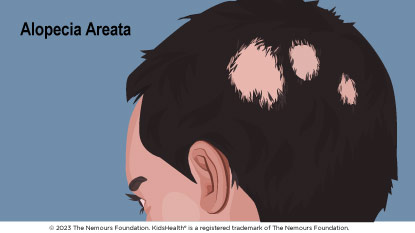Alopecia Areata: How to Care for Your Child
Alopecia areata (al-uh-PEE-shuh air-ee-AH-tuh) causes patchy hair loss on the scalp and sometimes elsewhere on the body. Treatment for alopecia areata isn't usually necessary, but medicine applied to the scalp may help hair grow back faster. Sometimes, injections and oral medicines are used instead. No treatment can cure alopecia areata, and hair loss can still happen again.
The hair loss that comes with alopecia areata can be upsetting, but it is not contagious and usually happens in people who are otherwise healthy.


-
Apply any prescribed skin creams or lotions as directed by your health care provider.
-
Apply sunscreen to any exposed areas of the scalp and skin before your child goes outdoors.
-
Your child has many cosmetic options for dealing with hair loss. Some kids like to cover their areas of hair loss with a wig, hair wrap, or hat. Other kids may prefer to shave their heads.
-
False eyelashes are an option for older children who have lost their eyelashes.
-
Therapy or alopecia areata support groups are good resources for helping your child deal with negative feelings about hair loss.

Your child:
-
seems depressed
-
develops a rash or skin irritation from the treatment
-
develops signs of a skin infection, such as redness, swelling, warmth, tenderness, fever, or discharge

What happens when someone has alopecia areata? Boys and girls both can get alopecia areata, which can begin at any age. It is believed to happen when the body's immune system, which normally fights infections, attacks the hair follicles as if they were a threat. A hair follicle is a small pit in the skin from which a hair grows. Damage to the hair follicles disrupts hair growth.
Alopecia areata often starts as one or more round, smooth bald patches on the scalp. While uncommon, it is possible for all the hair on the head to fall out. Often, hair grows back within several months, even without treatment. Very rarely, the hair loss is permanent.
Hair may grow in fine or white at first, but usually returns to its original texture and color with time. Kids with alopecia areata may lose and grow back their hair more than once, either in the same patches as before or in different patches.
Alopecia areata also can affect the fingernails and toenails. White spots may appear on the nails, the nails may feel pitted, grooved, or rough, or they may be thin and easily split.